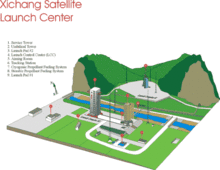Xichang Satellite Launch Centre
| Xichang Satellite Launch Center | |
|---|---|
| 西昌卫星发射中心 | |

Xichang Satellite Launch Center
|
|
|
Location within Sichuan
|
|
| Alternative names | Base 27 |
| General information | |
| Location | Xichang, Liangshan, Sichuan |
| Coordinates | 28°14′45.66″N 102°1′35.60″E / 28.2460167°N 102.0265556°E |
| Opened | 1984 |
| Xichang Satellite Launch Center | |||||||
 |
|||||||
| Simplified Chinese | 西昌卫星发射中心 | ||||||
|---|---|---|---|---|---|---|---|
| Traditional Chinese | 西昌衛星發射中心 | ||||||
|
|||||||
| Transcriptions | |
|---|---|
| Standard Mandarin | |
| Hanyu Pinyin | Xīchāng Wèixīng Fāshè Zhōngxīn |
The Xichang Satellite Launch Center (XSLC), also known as the Xichang Space Center, is a People's Republic of China space vehicle launch facility (spaceport) approximately 64 kilometres (40 miles) northwest of Xichang, Liangshan Yi Autonomous Prefecture in Sichuan.
The facility became operational in 1984 and is primarily used to launch powerful thrust rockets and geostationary communications and weather satellites. It is notable as the site of Sino-European space cooperation, with the launch of the first of two Double Star scientific satellites in December 2003. Chinese officials have indicated interest in conducting additional international satellite launches from XSLC.
In 1996, a fatal accident occurred when the rocket carrying the Intelsat 708 satellite failed on launch from the Xichang Satellite Launch Center. Also, a 2007 test of an anti-satellite missile occurred from the center.
In order to support the Chinese Project 714 manned space program in the 1960s, the construction of a new space center at Xichang in the Sichuan province was decided, located farther from the Soviet border, thus safer. The Shuguang One spacecraft was expected to be launched from the launch pad number one. After the cancellation of the program the launch pad was never completed. Today a viewing platform for officials has been built at the site.
China launched its first Long March-2E carrier rocket on July 16, 1990, sending into orbit Pakistan's first indigenously developed Badr-1 satellite and HS-601.
...
Wikipedia

